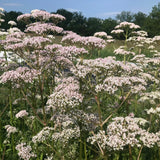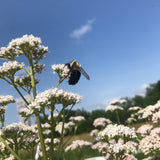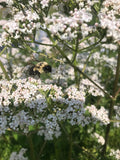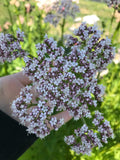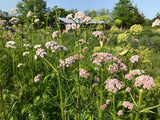Valerian
Valeriana officinalis
Valerian is a tall and lush herbaceous perennial, native to Europe and Northern Asia. It has been used for medicine for ages, including in Celtic tradition. In medieval times it was called “all heal”.
Valerian root is a mild sedative, and is used to treat insomnia. The root can be made into a tea or a tincture. If using for medicine, cut off the flowers as soon as they appear to allow the root to grow to its full potential. (If growing out for seed, let the flowers bloom of course). Harvest the root in the autumn of the second growing year. Valerian combines especially well with St. John's wort, making a nice remedy for anxiety.
Valerian enjoys full sun to partial shade and is an easygoing plant that adapts well to a wide range of conditions. Throughout the summer from its second year onward, Valerian has white flowers with a tinge of light pink on stalks five feet tall, attracting many pollinators. Hardy zones 4 to 8.
Photos from Run Rig Farm Project, except for wild valerian root harvest.
Days to root harvest: ~500
Seeds per pack: 70
Germination rate: 83% on 08/27/2024
Planting / harvesting notes
Sow seeds and firmly tamp them into the surface of your potting soil (they require light for germination). Keep evenly moist until germination. After the emergence of true leaves, up-pot the seedlings into larger pots. Transplant after hardening-off the seedlings, 1-2 feet apart. Roots are dug in the fall of the second year when leaves begin to turn yellow and die back.
Seed keeping notes
Harvest seeds when flowers have faded, seeds have fattened, and before they blow away on the wind!







